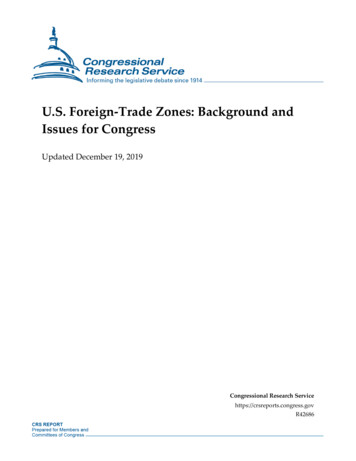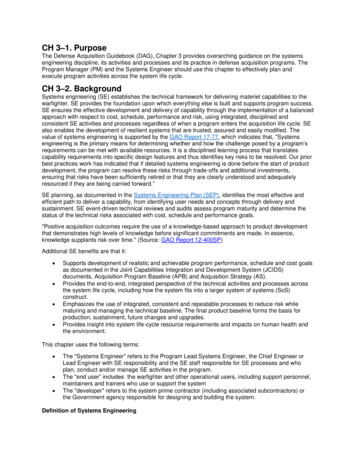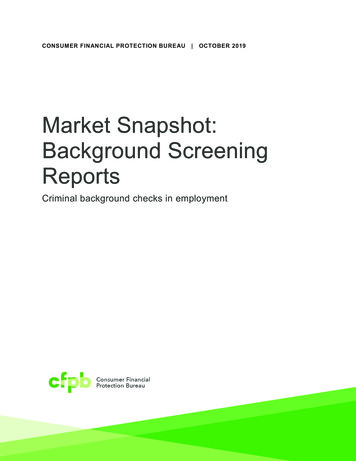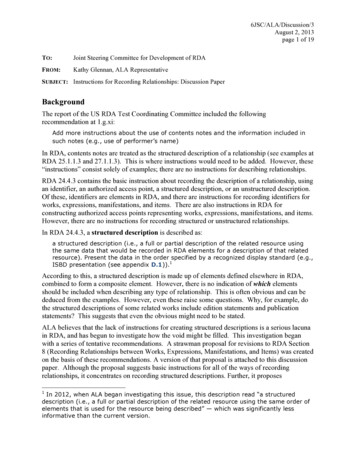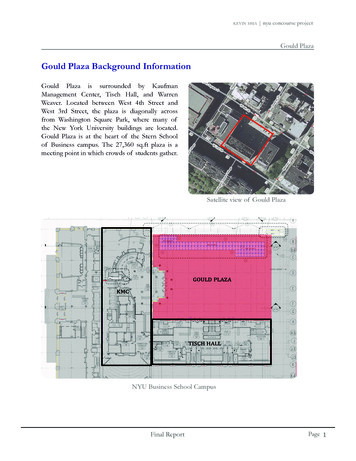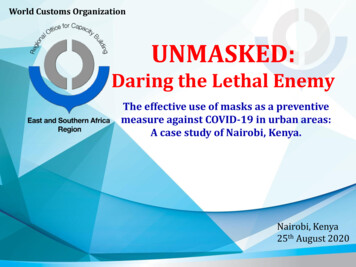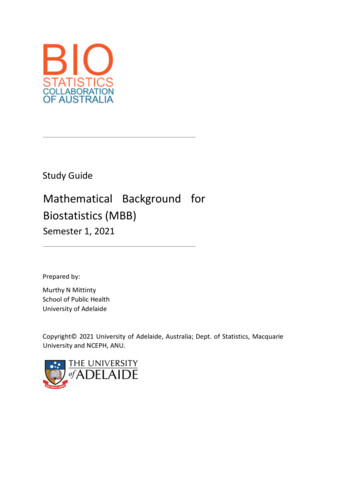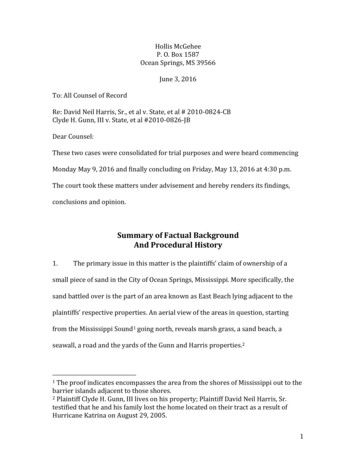
Transcription
Hollis McGeheeP. O. Box 1587Ocean Springs, MS 39566June 3, 2016To: All Counsel of RecordRe: David Neil Harris, Sr., et al v. State, et al # 2010-0824-CBClyde H. Gunn, III v. State, et al #2010-0826-JBDear Counsel:These two cases were consolidated for trial purposes and were heard commencingMonday May 9, 2016 and finally concluding on Friday, May 13, 2016 at 4:30 p.m.The court took these matters under advisement and hereby renders its findings,conclusions and opinion.Summary of Factual BackgroundAnd Procedural History1.The primary issue in this matter is the plaintiffs’ claim of ownership of asmall piece of sand in the City of Ocean Springs, Mississippi. More specifically, thesand battled over is the part of an area known as East Beach lying adjacent to theplaintiffs’ respective properties. An aerial view of the areas in question, startingfrom the Mississippi Sound1 going north, reveals marsh grass, a sand beach, aseawall, a road and the yards of the Gunn and Harris properties.2The proof indicates encompasses the area from the shores of Mississippi out to thebarrier islands adjacent to those shores.2 Plaintiff Clyde H. Gunn, III lives on his property; Plaintiff David Neil Harris, Sr.testified that he and his family lost the home located on their tract as a result ofHurricane Katrina on August 29, 2005.11
2.In November 2009 the Secretary of State granted a lease to the City of OceanSprings. The lease covered a strip of sand adjacent to the seawall on East Beach forthe purpose of constructing a public sidewalk. The lease includes the area describedabove the ownership of which is the primary issue before the court.3.Gunn and Harris, upon finding out about the above referenced lease, soughtinjunctive relief to prevent the City of Ocean Springs from constructing a sidewalkon the sand beach adjacent to their property. The chancellor3 granted a permanentinjunction that prevented the City from constructing the sidewalk but refrainedfrom drawing property lines or declaring ownership. The Supreme Court vacatedthe chancellor’s grant of a permanent injunction and remanded the case withinstruction to continue the original preliminary injunction pending determination ofownership of the disputed property. The injunctive relief was sought in a separatebut related cause of action.3.In March 2010, Gunn and Harris initiated these two actions seeking to quietand confirm title to their record descriptions which they contend includes the sandbeach adjacent to their respective properties and south of the seawall to the highwater mark or high mean tide line. On April 30, 2010, the Secretary of State filed itsAnswer and Counterclaim asserting, among other things, that the sand beach wasOne of the plaintiffs, Honorable David Neil Harris, Sr. is a sitting chancellor inJackson County, Mississippi and thus all local chancellors recused. Subsequently twoother chancellors were appointed and later recused and the original case was triedbefore Special Chancellor Robert L. Lancaster. This case was reversed andremanded and upon remand the undersigned senior status judge, Hollis McGeheewas appointed by the Mississippi Supreme Court to hear this matter on remand.32
created by the filling of tidelands and therefore is owned by the State of Mississippias trustee for the public. The City and Jackson County, Mississippi (“County”) filedcounterclaims alleging that if the beach is determined to be natural and thereforenot owned by the State, then the City and County claim title to the beach throughadverse possession and/or prescriptive easement.4.Gunn and Harris sought and obtained a partial summary judgment. Thechancellor held (August 16, 2012) that the boundary of the tidelands was the meanhigh water line closest to July 1, 1973, and ruling that the State had failed in itsburden to produce admissible evidence showing the boundary was not this line.4The chancellor subsequently filed an Addendum to his opinion on the partialsummary judgment to distinguish his ruling from the Supreme Court’s ruling inMississippi State Highway Commission v. Gillich, 609 S0. 2d 367 (Miss. 1992). In theaddendum the chancellor recognized there was a dilemma between the TidelandsAct and the Harrison County beaches, but reaffirmed his original opinion and foundthat, unlike in Gillich, the State in this case did not produce admissible evidence thatthe sand beach was created by the filling of tidelands. The matter was subsequentlytried on the City and County’s claims of adverse possession and public prescriptiveeasements. The court held both entities failed to prove, by clear and convincingevidence, their respective claims to adverse possession and / or prescriptiveeasements. The court did find the County had a prescriptive easement inJuly 1, 1973, is the date of the enactment of the Coastal Wetlands Protection Act,which the Public Trust Tidelands Act uses to determine the boundary betweenprivate property and public tidelands in developed areas.43
maintaining the sand beach for seawall protection and the City had a prescriptiveeasement for road maintenance.5.The Mississippi Supreme Court found that the Chancellor was in error ingranting the partial summary judgment and reversed the grant of the partialsummary judgment and further stated, “we reverse the remaining aspects of thechancellor’s judgment as well. This case is remanded for a full trial on the merits.”Hosemann v Harris, 163 So. 3d 263 (2015).6.The courts have held that the issues and applicable law relating to theownership of tidelands are unclear and complicated; further, that the issues involvematters of significant public and private concern and economic impact. On morethan one occasion the courts have declared, by judicial fiat, that the issues involvedin deciding who owns tidelands have finally been clarified. Respectfully, I do not findsuch to be the case; when I read through the case law I feel as if I am wanderingbetween Hon. Soggy Sweat’s famous Whiskey Speech5 and the Bill Murray movieGroundhog Day6. I do not make the claim the larger conundrum of ownership oflands subject to the ebb and flow of the tides is laid to rest by this writing. Suffice itto say the issues involved and the decisions upon those issues are as murky as the5Delivered by the late Noah S. “Soggy” Sweat, Jr., former Mississippi legislator, lawyer andjudge, in 1952 when the Mississippi Legislature was considering legalizing liquor.4
nutrient rich waters of the Mississippi Sound. I do sincerely believe this opinionbrings clarity to the waters of this particular controversy.6.However, thankfully the Supreme Court, in remanding this matter, simplifiedthe resolution of this particular dispute when it stated: “It is undisputed that themean high water mark closest to July 1, 1973, is seaward of the sand beach.However, this Court’s holding in Gillich and the Fifth Circuit’s holding in HarrisonCounty show that the 1973 water line is not controlling with regard to sand beachescreated by filling in tidelands.”(Paragraph 34 of Hosemann). Therefore, the watersare somewhat cleared up in this matter; the first line of inquiry must be to ascertainwhether the disputed strip of sand is natural or man made. The resolution of thenatural versus man-made question will substantially control the outcome of thismatter.Findings of FactAnd Conclusions of Law7.The plaintiffs’ cause of action is for confirmation of title. No persons orentities, other than the named parties and citizens who testified and expressed theirdisagreement, appeared to contest the plaintiffs’ confirmation actions.8.The parties requested that the court view the area in question in this action.Pursuant to the parties’ request, the court recessed and the court and counsel met atGroundhog Day is a 1993 movie directed by Harold Ramis and starring Bill Murrayin which a weatherman finds himself reliving the same day over and over.65
the Mississippi Gulf Coast Research Laboratory just east of the east end of EastBeach. The parties, through counsel, agreed in advance the items they wished thecourt to view. The court, as requested, viewed the Gunn and Harris tracts of land,East Beach, the roadway, sea wall, the Gulf Coast Research Laboratory pier, and thegeneral lay out of the entire area. The court also viewed the marshy area on thenorth end of the Harris tract from the public bridge on Halstead Road.9.The Gunn/Harris properties are a part of Lot 1, Fractional Section 32,Township 7 South, Range 8 West, Jackson County, Mississippi as reflected on theoriginal 1828 township plat. Exhibit G-25 in evidence. The south boundary ofFractional Section 32 is shown as the water’s edge.6
10.The Gunn/Harris property comes out of the United States of America bypatent to Caillavet dated February 2, 1837. Exhibits G-1 and H-1 in evidence.11.Every conveyance in the Gunn/Harris title deraignment includes a call forsouth “to the water’s edge,” or describes the property as having a southernboundary on the water’s edge or describes the property as being the same propertyas that previously conveyed by such a description. Most of the conveyances alsoinclude a call of running east (or west) along the water’s edge as a part of thedescription.12.The undisputed law in Mississippi, since at least 1839, Newman v. Foster’sHeirs, 4 Miss. 383, 389 (Miss. 1839); Holcomb v. McClure, 52 So. 2d 922, 924 (Miss.1951) is that “when monuments and distances are both given, the monumentscontrol and the distances must be lengthened or shortened if necessary to preventinconsistency”. However, this rule of construction does not override the constitutionand the common law as it relates to ownership of lands in the sovereign.13.A survey of the boundaries of the Gunn property by Larry Rumsey wasoffered into evidence, G-17, and a survey of the Harris property, H-8. The accuracyof the Rumsey surveys is undisputed by opposing survey, however, Mr. Rumseymade it clear that he made no investigation whatsoever into the record title. Hestated he took what had been handed to him and he placed that information on the7
ground without further investigation in the land records of Jackson County. TheGunn survey is tied to monuments. Gunn tract is bounded by Ashley PlaceSubdivision on the west; Halstead Bayou Subdivision on the north; the Striegelproperty on the east; and either the roadway, seawall and / or the water’s edge onthe south. The Harris survey is likewise tied to monuments. The Harris tract isbounded by the Striegel property on the west; edge of marsh on the north; a lineapproximately 282 feet west of Halstead Road on the east and the roadway, seawalland / or the water’s edge on the south.14.The confirmation statute, Miss. Code §§ 11-17-29 et seq., requires publicationfor any person claiming any interest whatsoever in property to be confirmed. Thatpublication was duly made for Gunn and for Harris and Proof of Publication filed ineach case on October 4, 2010. No party contested the west boundary, or the northboundary, or the east boundary of the Harris property. The Court in the prior trialentered judgment to that effect. No appeal was taken. However, the Supreme Courtreversed the prior chancellor’s ruling and sent the matter back for a new trial. In sofar as the north boundary of the Harris tract, the Secretary of State’s tidelands map(Exhibit G-21) does not show the presence of any tidelands along the north portionof the Harris property.7 The only challenge to plaintiffs’ titles came from thedefendants with respect to the south boundary.15.7The plaintiffs argue their deed calls and supporting survey to the “water’sThe statutory definition of tidelands. Miss. Code § 29-15-1(h).8
edge” establish perfect title to the water’s edge for each of their respective tracts.The plaintiffs are generally correct in their contention that the calls, with littleexception, go to the water’s edge (using varying terminology for such water’s edge)and usually go further and describe the property as running along the water’s edge.The defendants, particularly the State, counter with the dual argument thatfollowing the metes and bounds description (referencing the Northeast Corner ofthe Section – 32) establishes the southern boundary of plaintiffs’ property as beingsomewhere at or about the north edge of the public roadway. The evidence supportsa finding that, prior to the construction of the new seawall (1950s) the mean hightide was in the area just south of the yards of Harris and Gunn or approximately thenorth edge of the current public roadway. The state contends that, regardless of anydeed call, the area in dispute was a part of the original grant to the State by theUnited States. If the disputed area is a part of the sovereign, then the overlappingprivate conveyance description can never ripen into title contrary to the ownershipof the State. Upon admission into the Union in 1817, the State of Mississippi wasgranted title to all lands subject to the ebb and flow of the tide and up to the meanhigh water level (or mean high tide line) to be held in trust for the public benefit.Thereafter, the State of Mississippi remains at all times the legal title owner to alllands over which the tide ebbs and flows. Such lands are commonly referred to astidelands. See Cinque Bambini Partnership v. State of Mississippi, 491 So.2d 508,514 (Miss. 1986); Hosemann v. Harris, 163 So.3d 263, 268-69 (Miss. 2015) (“Whenadmitted into the Union, the State of Mississippi was granted title to lands subject tothe ebb and flow of the tide); Mississippi State Highway Commission v. Gilich, 6099
So.2d 367, 374 (Miss. 1992) (quoting Parks v. Simpson, 137 So.2d 136 (1962))(“This Court, by an unbroken line of decisions over 100 years, has declared that theState ‘is the owner of lands in the beds of all its shores, inlets, and adjacent to theislands, over which the tides of the sea ebb and flow, and that it holds title as trusteefor the people of the State.’”) (Citations omitted). If na
between Hon. Soggy Sweat’s famous Whiskey Speech5 and the Bill Murray movie Groundhog Day6. I do not make the claim the larger conundrum of ownership of lands subject to the ebb and flow of the tides is laid to rest by this writing. Suffice it to say the issues involved and the decisions upon those issues are as murky as the 5 Delivered by the late Noah S. “Soggy” Sweat, Jr., former .

